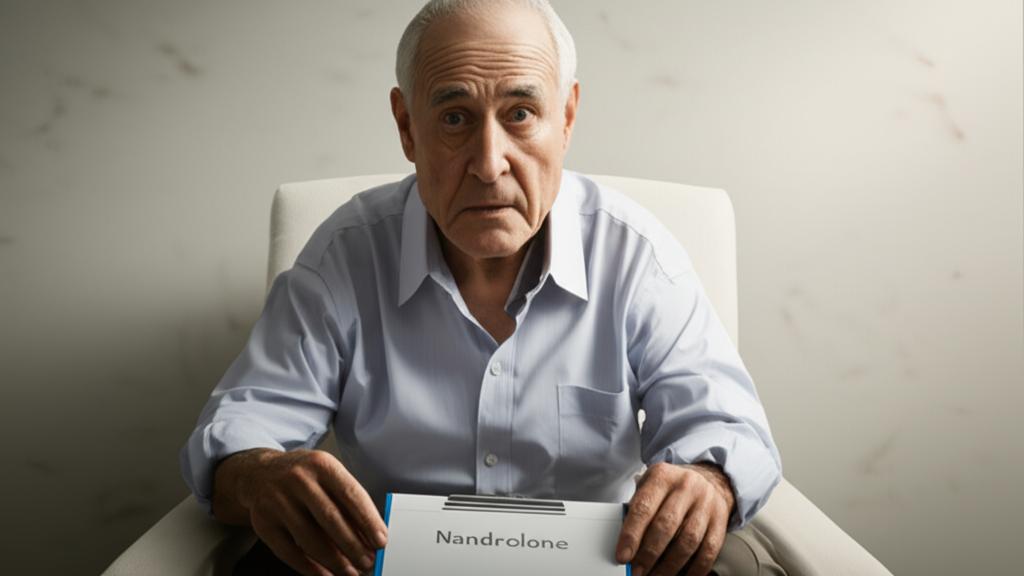I remember a patient, a gentleman in his late 60s with Chronic Kidney Disease, who was just exhausted. Not tired—truly, deeply exhausted. His body wasn’t making enough red blood cells, a condition we call anemia, and it was stealing his life away. In his specific case, after exploring other options, we discussed a powerful medication that could help his body build back what it had lost. That medication was Nandrolone. It’s a tool we have in our medical toolbox, but it’s one we handle with extreme care because of its dual nature: it can heal, but it can also cause serious harm, especially when misused.
What Exactly Is Nandrolone?
Think of Nandrolone (you might hear the brand name Deca-Durabolin®) as a lab-made cousin of the hormone testosterone. Because of this, it belongs to a class of drugs called anabolic-androgenic steroids.
That sounds complicated, I know. Let’s break it down.
- Anabolic: This just means “building up.” The anabolic part of this drug is what helps build tissues, like muscle, and stimulates the production of red blood cells. This is the property we harness for medical reasons.
- Androgenic: This refers to the development of male characteristics. Testosterone is the primary androgen in men.
Scientists designed Nandrolone to be more “anabolic” (tissue-building) and less “androgenic” (masculinizing) than natural testosterone. But it’s impossible to separate the two effects completely. It’s still a powerful hormone, and adding it to your system has consequences.
When Do We Medically Prescribe It?
In the clinic, we reserve Nandrolone for very specific situations where the benefits can outweigh the risks. It’s given as an injection into a muscle, always under a doctor’s supervision.
The primary, approved use is to treat anemia that’s caused by chronic kidney failure. It can also be a part of treatment for:
- Osteoporosis in postmenopausal women, to help build bone density.
- Certain types of breast cancer.
- Severe muscle wasting, sometimes seen in conditions like AIDS.
Because of its potential for misuse and serious side effects, Nandrolone is a Schedule III controlled substance in the U.S. This means it’s illegal to have or use it without a valid prescription. It’s important to know that while it is FDA-approved, manufacturers are not currently distributing it in the United States, though it’s available in other countries.
The conversation around steroids is often dominated by stories of misuse in sports and bodybuilding. People use it to “bulk up,” often at dangerously high doses, chasing muscle gain while ignoring the immense risks. This is not its intended purpose and can lead to devastating health problems.
The Two Sides of Nandrolone: Side Effects and Risks
Every medication has potential side effects, but because Nandrolone is a hormone, its effects can be widespread and sometimes permanent. This is why close monitoring is non-negotiable.
Common general side effects can include:
- Headaches
- Acne flare-ups
- Upset stomach or diarrhea
- Swelling in your legs and ankles (edema)
- Trouble sleeping
- Mood swings, from irritability to depression
The more specific side effects depend on your sex and age.
| Who is Affected | Potential Side Effects to Watch For |
|---|---|
| Men (After Puberty) | • Development of breasts (gynecomastia) • Shrinking of the testicles (testicular atrophy) • A lower sperm count • Persistent, painful erections or trouble getting one • Changes in sex drive (either up or down) |
| Women | • A deeper, more masculine voice (can be permanent) • Growth of facial or body hair (hirsutism) • Male-pattern baldness • Enlargement of the clitoris • Irregular or stopped menstrual periods |
| Children | • The most significant risk is that it can cause a child’s bones to stop growing too early, stunting their final adult height. Regular monitoring is essential. |
The Most Serious Dangers
Beyond those side effects, there are even more severe risks, especially with high doses or long-term use. These are the ones that truly worry us as doctors:
- Liver Damage: This can range from tumors (usually benign, but not always) to a dangerous condition called peliosis hepatis, where blood-filled cysts form in the liver. These can rupture and cause life-threatening internal bleeding.
- Cardiovascular Problems: Nandrolone can mess with your cholesterol levels, leading to plaque buildup in your arteries (atherosclerosis). This hardens the arteries and dramatically increases your risk of a heart attack or stroke.
It’s crucial to tell your doctor everything about your health history before starting a medication like this. We need to know if you have heart, kidney, or liver problems, or if you might be pregnant or are breastfeeding. You should not take Nandrolone if you are pregnant.
Take-Home Message
- Nandrolone is a powerful anabolic steroid, a synthetic version of testosterone, used medically to treat specific conditions like anemia from kidney failure.
- It is NOT a fitness supplement. Using it without a prescription for bodybuilding is illegal and extremely dangerous.
- Side effects are common and can be permanent. They include hormonal changes in both men and women, such as gynecomastia or a deepened voice.
- The most severe risks involve potentially fatal liver damage and an increased chance of heart attack and stroke.
- Always use this medication exactly as prescribed and under the close watch of a healthcare provider. Honest communication with your doctor is key to your safety.
This isn’t a drug to be taken lightly. It has a real, and sometimes necessary, place in medicine. But that place is a carefully controlled one, guided by a deep respect for its power.
If you ever have questions about medications, hormones, or supplements, please talk to us. We’re here to give you the straight facts and help you stay safe. You’re not alone in this.


